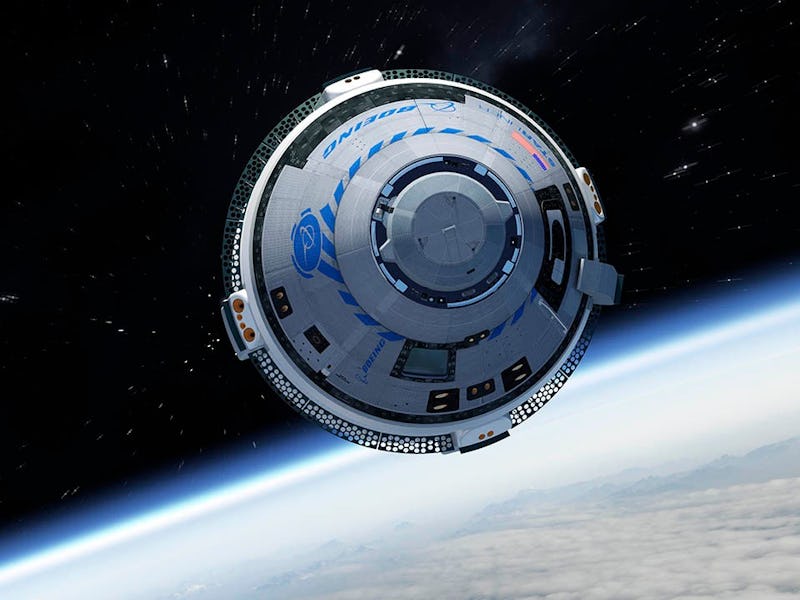NASA Only Has One Spacecraft to Get to Space — Boeing’s Starliner Could Be the Second
Two astronauts are testing the Boeing Starliner in a few weeks.

Right now, if the United States wanted to send humans to the International Space Station (ISS) or anywhere else in space, NASA would have limited options. The SpaceX Crew Dragon spacecraft is currently the only vehicle whose company NASA has a relationship with that can take its astronauts out of Earth’s atmosphere. If the Crew Dragon couldn’t make the trip, NASA would have to ride on another country’s rocket. Now, NASA could be one step closer to another workable option: the Boeing Starliner.
At a news conference on Friday, NASA and Boeing announced that the Starliner is still on track for its Crewed Flight Test (CFT) currently scheduled for May 1. If all goes according to plan and Starliner launches to the space station successfully on May 1, the capsule would become the newest human-rated spacecraft to service low-Earth orbit and finally give NASA’s Commercial Crew Program (a private sector partnership to make astronaut launches cheaper and more frequent) a plan B in space.
A Plan B for space
As part of its Crewed Flight Test (CFT), Starliner will fly astronauts Suni Williams and Barry “Butch” Wilmore to the ISS for a mission lasting just under two weeks.
A depiction of Boeing Starliner docking with the International Space Station (ISS).
Boeing has reached this point after conducting an uncrewed flight test in December 2019. On this mission, Orbital Flight Test, Starliner failed to reach the planned orbit, nor did it dock at the ISS as planned. But Starliner’s Orbital Flight Test 2 in May 2022 succeeded.
“It was very successful. But now, we introduce the human,” Mark Nappi, Starliner program manager at Boeing, said on Friday.
Boeing has spent the last six months trying to resolve two issues that came up during testing last summer, Nappi said, which concerned the parachute system and tape that was flammable. But the addition of material and stitching to the parachute, and a drop test, plus the removal of “nearly a mile of tape” and mitigation measures for where the tape remains, have fixed the problems. “We can safely say those issues are behind us,” he said.
There’s a few items left to check off before May 1. Right now, NASA and Boeing are conducting abort certification.
“We set some pretty stringent standards for these vehicles to have an ability to abort off the launch vehicle should it have a problem during ascent,” Steve Stich, manager of NASA’s Commercial Crew Program, said on Friday.
NASA astronaut Frank Rubio and two Russian cosmonauts landed on September 27, 2023. Halfway through the trio’s mission to the space station, planned originally to last six months, a micrometeoroid struck the Soyuz space capsule that brought them up and which would have returned them home. Flying a replacement and adhustments to crew scheduling extended their space stay to 371 days. Rubio broke the record of longest single duration spaceflight for a U.S. astronaut.
Chief engineers are also currently interrogating their work, doubling down on their checks, as part of the flight-readiness process that Stich said will end around mid-April.
A reliable backup plan
When a micrometeoroid punctured through layers of the Soyuz MS-22 spacecraft in December 2022, liquid coolant spewed out into space and rendered the vehicle unsuited for human passengers.
This would have caused space traffic if the scenario played out before 2020. But that year, SpaceX flew two astronauts to the ISS for the first time and ushered in a new era not seen since the Space Shuttle, when NASA could launch its own astronauts on US-built rockets. The SpaceX Crew Dragon spacecraft has now flown eight crewed missions into orbit.
Since the Crew Dragon had notched several trips when Soyuz MS-22 leaked, NASA had a reliable backup plan and could continue flying astronauts up to the space station and back down, sharing in the work with the three stranded onboard, as they maintained the orbiting laboratory and conducted scheduled science experiments.
“We have a lot of things that the crew does for us in terms of corrective and preventative maintenance to keep the [ISS] systems going,” Dana Weigel, deputy manager of the ISS Program at NASA, told reporters on Friday.
“The Soyuz coolant leak is a great example. Where we had a problem on one type of spacecraft and we were able to leverage contingency capability, in this case, with Crew Dragon,” she added.
NASA says it hopes Boeing’s Starliner passes its crewed flight so that failures in space can be remedied quickly.